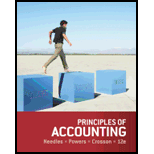
Concept explainers
David Roberts began an upholstery cleaning business on August 1 and engaged in the following transactions during the month:
Aug. 1 Began business by depositing $30,000 in a bank account in the name of the company.
2 Ordered cleaning supplies, $6,000.
3 Purchased cleaning equipment for cash, $5,600.
4 Made two months’ van lease payment in advance, $2,400.
7 Received the cleaning supplies ordered on August 2 and agreed to pay half the amount in 10 days and the rest in 30 days.
9 Paid for repairs on the van with cash, $2,160.
12 Received cash for cleaning upholstery, $1,920.
17 Paid half the amount owed on supplies received on August 7, $3,000.
21 Billed customers for cleaning upholstery, $2,680.
24 Paid cash for additional repairs on the van, $160.
27 Received $1,200 from the customers billed on August 21.
31 Made a cash withdrawal of $1,400.
REQUIRED
- 1. Set up the following T accounts: Cash;
Accounts Receivable ; Cleaning Supplies; Prepaid Lease; Cleaning Equipment; Accounts Payable; D. Roberts, Capital; D. Roberts, Withdrawals; Cleaning Revenue; and Repair Expense. - 2. Record transactions directly in the T accounts. Identify each entry by date.
- 3. Prepare a
trial balance for Roberts Upholstery Cleaning as of August 31, 2014. - 4. CONCEPT ► Compare and contrast how the issues of recognition, valuation, and classification are settled in the transactions of August 7 and 9.
Want to see the full answer?
Check out a sample textbook solution
Chapter 2 Solutions
Principles of Accounting
- Solve this Answerarrow_forwardLet us suppose that the Apex Corporation's total annual sales are 4,800 units, the average inventory level is 400 units, and the annual working days are 320 days. The inventory days of supply (DOS) are____. a. Somewhere between 30 and 31 days. b. 26.67 days. c. 20.38 days. d. None of the above.arrow_forwardWhat is the amount of current liabilitiesarrow_forward
- Need answerarrow_forward4 Pointarrow_forwardThe monthly cost (in dollars) of a data plan for Mercury Communications is a linear function of the total data usage (in gigabytes). The monthly cost for 25 gigabytes of data is $45.50 and the monthly cost for 40 gigabytes is $58.00. What is the monthly cost for 28 gigabytes of data? Step by step answerarrow_forward
- Principles of Accounting Volume 1AccountingISBN:9781947172685Author:OpenStaxPublisher:OpenStax College
 Individual Income TaxesAccountingISBN:9780357109731Author:HoffmanPublisher:CENGAGE LEARNING - CONSIGNMENT
Individual Income TaxesAccountingISBN:9780357109731Author:HoffmanPublisher:CENGAGE LEARNING - CONSIGNMENT  Auditing: A Risk Based-Approach to Conducting a Q...AccountingISBN:9781305080577Author:Karla M Johnstone, Audrey A. Gramling, Larry E. RittenbergPublisher:South-Western College Pub
Auditing: A Risk Based-Approach to Conducting a Q...AccountingISBN:9781305080577Author:Karla M Johnstone, Audrey A. Gramling, Larry E. RittenbergPublisher:South-Western College Pub




